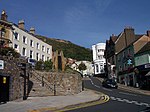Holy Trinity Church, Malvern Link
Buildings and structures in Malvern, WorcestershireChurch of England church buildings in WorcestershireGrade II listed churches in WorcestershireUnited Kingdom Anglican church building stubsUse British English from September 2019

The Church of the Holy Trinity in North Malvern, Worcestershire, England is an Anglican church built in 1850–51 with money raised by subscription. Designed by the Victorian architect Samuel Daukes, with a number of additions made between 1872 and 1909, the church was given a Grade II heritage listing in 2008. Holy Trinity Church remains a functioning place of worship.
Excerpt from the Wikipedia article Holy Trinity Church, Malvern Link (License: CC BY-SA 3.0, Authors, Images).Holy Trinity Church, Malvern Link
North Malvern Road, Malvern Hills Malvern
Geographical coordinates (GPS) Address External links Nearby Places Show on map
Geographical coordinates (GPS)
| Latitude | Longitude |
|---|---|
| N 52.119945 ° | E -2.330215 ° |
Address
Holy Trinity
North Malvern Road
WR14 4LR Malvern Hills, Malvern
England, United Kingdom
Open on Google Maps










